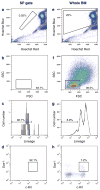Hematopoietic stem cell characterization and isolation
- PMID: 21618082
- PMCID: PMC3621966
- DOI: 10.1007/978-1-61779-145-1_3
Hematopoietic stem cell characterization and isolation
Abstract
Hematopoietic stem cells (HSCs) are defined by the capabilities of multi-lineage differentiation and long-term self-renewal. Both these characteristics contribute to maintain the homeostasis of the system and allow the restoration of hematopoiesis after insults, such as infections or therapeutic ablation. Reconstitution after lethal irradiation strictly depends on a third, fundamental property of HSCs: the capability to migrate under the influence of specific chemokines. Directed by a chemotactic compass, after transplant HSCs find their way to the bone marrow, where they eventually home and engraft. HSCs represent a rare population that primarily resides in the bone marrow with an estimated frequency of 0.01% of total nucleated cells. Separating HSCs from differentiated cells that reside in the bone marrow has been the focus of intense investigation for years. In this chapter, we will describe in detail the strategy routinely used by our laboratory to purify murine HSCs, by exploiting their antigenic phenotype (KSL), combined with the physiological capability to efficiently efflux the vital dye Hoechst 33342, generating the so-called Side Population, or SP.
Figures


References
-
- Dykstra B, Kent D, et al. Long-term propagation of hematopoietic differentiation programs in vivo. Cell Stem Cells. 2007;1:218–29. - PubMed
-
- Morrison SJ, Weissman IL. The long-term repopulating subset of hematopoietic stem cells is deterministic and isolatable by phenotype. Immunity. 1994;1:661–73. - PubMed
-
- Goodell MA, Rosenzweig M, et al. Dye efflux studies suggest that hematopoietic stem cells expressing low or undetectable levels of CD34 antigen exist in multiple species. Nat Med. 1997;3:1337–45. - PubMed
Publication types
MeSH terms
Substances
Grants and funding
LinkOut - more resources
Full Text Sources
Other Literature Sources
Medical

